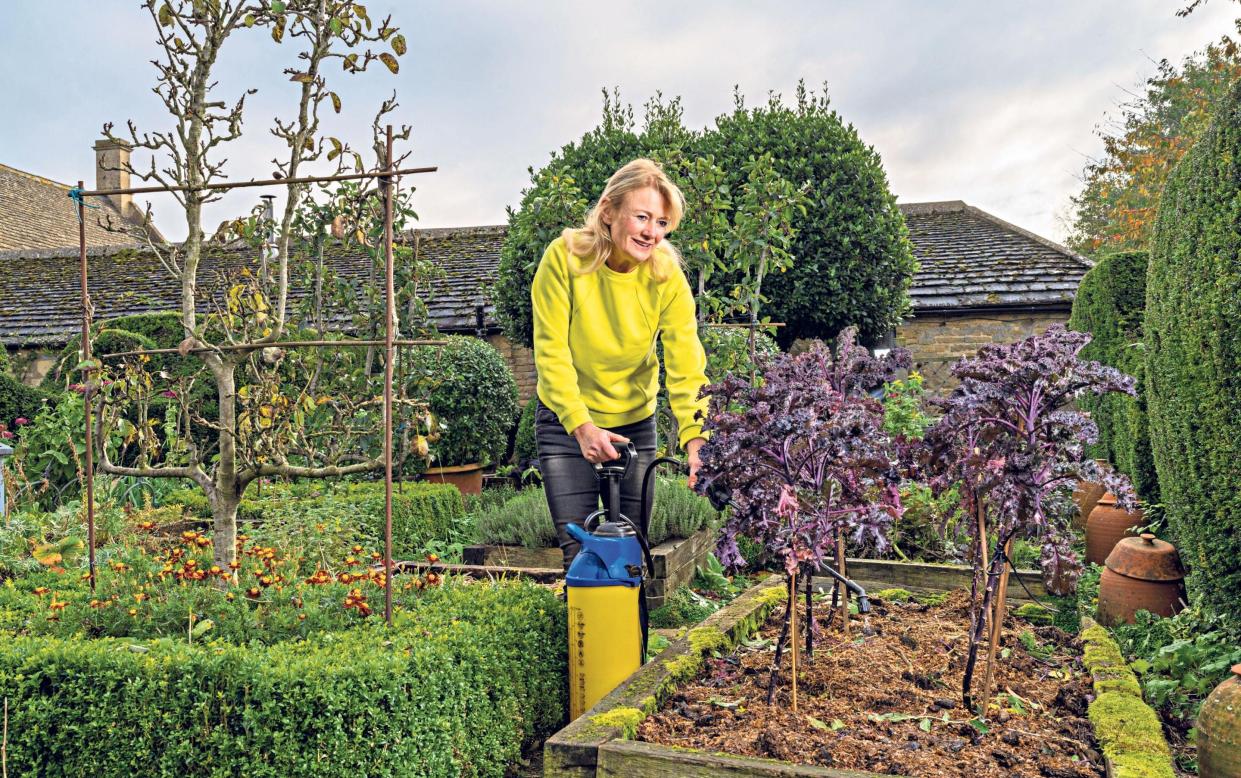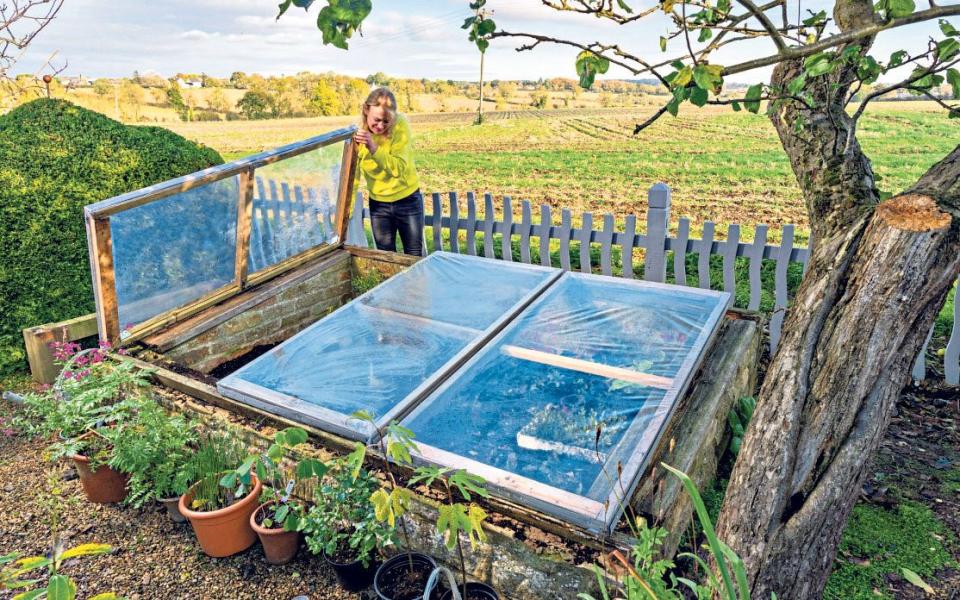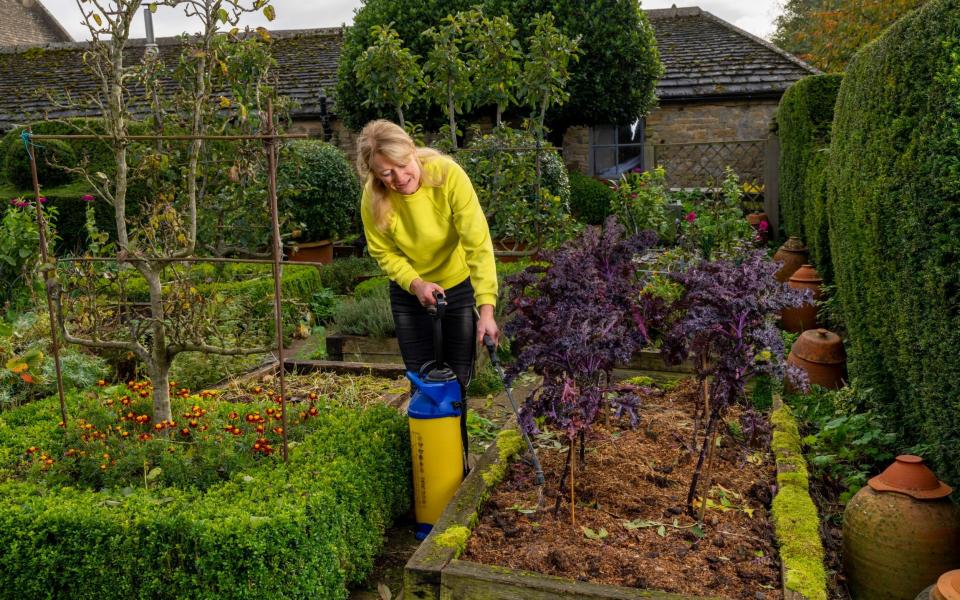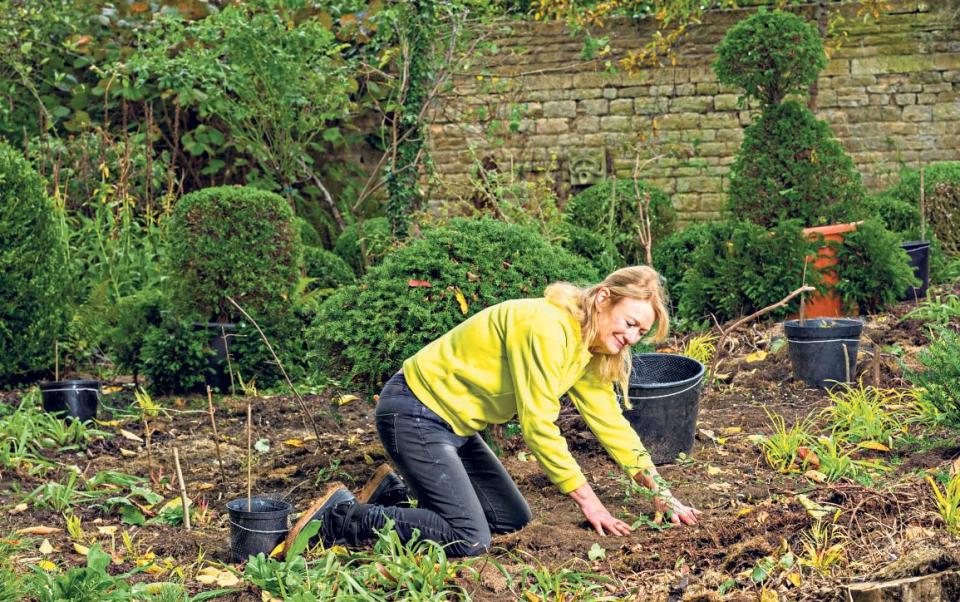Why winter is the best time to experiment in the garden

November was full of revelations for me. I had not realised there is a fantastic glass substitute out there – ETFE (short for Ethylene tetrafluoroethylene) film – it is the same price as horticultural glass, is far more durable and allows the full spectrum of natural light through. Now, excitingly, it is just becoming available for gardeners, rather than just commercial growers.
Phillip Lee, founder of Ripe, offered to fit some ETFE film to three old Dutch lights (bought second-hand about 30 years ago) that cover my cold frame. Lee designed and built the first ETFE greenhouse during his PhD research in the UK in 2006, and more recently built the Natural Light Growing Centre at Warwick University to study the effects of plant growth under ETFE.
Once again, the glass in my cold frame had been smashed in a storm (by apples from a tree), but Lee assured me the ETFE would easily cope with apples bouncing off it. If it does get a hole in it, it stays that size and does not spread. You can cover the hole with some special tape.
Another reason for its appeal to me is that ETFE is self-cleaning: moss, algae, dust and bird poo debris just will not grow or settle on it. When you grow under glass or poly, this debris drastically reduces the light levels, which stresses the plants and causes them to grow in an etiolated way.
Plants grown under ETFE are stronger, with shorter distances between their nodes and, in trials, the produce has been convincingly shown to be more flavoursome, with a higher vitamin content; crop yields potentially increase by five to 15 per cent.

Finally, plants grown under ETFE do not need as much hardening off before planting outside, as they are already getting exactly the same light spectrum undercover as they would outside.
ETFE has a lifespan of 20 years minimum, but architects often quote 50 years. And it is completely recyclable and reusable. There are two types of film, clear and opaque, and they are both amazingly thin – 100 micrometers – similar to a sheet of thinnish paper. I tried to manually rip a sample, but could not.
Lee strengthened the wood on my old frames as best he could (the film needs to be taut), then covered them with the film. Inevitably there are a few minor ripples, but the newly clad frames are now snugly in place and I am putting trays of seedlings for my new rose meadow inside (see above), plus trays of cuttings and vegetable seedlings.
The film does appear slightly more opaque than the old glass; this is because there is a naturally inherent light diffusion, which is beneficial to plants. The insulation value of a single layer of ETFE is slightly better than standard 3mm horticultural glass, but, when used as a double layer, it is significantly warmer than glass.
How to kill a tree stump

I have just chopped down an old tree that was originally a sucker from a fruit tree. It was growing with several stems perilously close to our garden wall.
A simple way to prevent the stump regrowing is to insert an Ecomax plug, which releases glyphosate into the stump and kills it. You drill a hole in the cut stump (with a half-inch drill bit) 1-1½ inches deep and close to the bark, then simply hammer in the small plugs.
These release the chemical into the stump and kill it. This treatment is ideal for old ivy stumps, too. You may need more than one plug depending on the size of the tree.
To use this product, however, you need to have taken your PA1 and PA6pp Spray exams, which I often mention: pretty straightforward and well worth doing. Quite a few “non-chemical” products also need the exams, such as the excellent biological control for box moth, Dipel.
How to improve your soil quality

I have long been a fan of microbiologist Dr Elaine Ingham. She has been researching the make-up of the soil food web for more than four decades and her work on how best to feed plants stands many gardening beliefs on their heads.
Dr Ingham says that all soils on the planet have enough elements in them to support plant growth – but that plants need far more elements than NPK, plus the regular trace elements habitually trotted out. She believes it is the soil microorganisms that make the growing medium work effectively.
These microorganisms consist of many million different fungi, protozoa, bacteria, nematodes and microarthropods. The best way to see how rich your soil is is either to get it tested or, as Ingham says, look at it through a microscope.
A simpler way advocated by some is to bury an old pair of cotton pants in the soil and see how quickly they break down. If they are still intact after a few months, microbial activity is probably low.
Daniel Tyrkiel studied under Ingham and has since set up the Soil Ecology Laboratory. The exciting news is that, in addition to testing your soil, Tyrkiel’s company has launched a soil inoculant that can boost the levels of vital organisms. He sent me some to try, which I watered onto my raised beds.
Green waste, which I use a fair bit as a mulch, tends to contain only bacteria, no protozoa, fungi or nematodes. So, ideally, I should modify it.
For this, Tyrkiel is launching The Goop – a semi-liquid inoculant – and another product, The Fluff, with a granular texture that is, in effect, a slow-release inoculant. He also plans to launch a microbial-rich compost.
All products will come with a batch count of microbes, so you know what concentration of microbes you are applying. These products are primarily aimed at agriculture and commercial horticulture, but the enlightened gardener can benefit, too.
I recommend this book, with a foreword by Dr Ingham: Teaming With Microbes by Jeff Lowenfels and Wayne Lewis (Timber Press).
Frost warning

The grass crunched under my feet from a ground frost in the early morning of November 2, even though the temperature was a couple of degrees above zero.
Peter Gibbs (weatherman and regular chair of Gardeners’ Question Time) informed me that the ground temperature is almost always a few degrees lower than air temperature on a clear night. I also thought this was early for a frost, but he put me right on this.
Apparently, Met Office studies show frost occurrence has fallen significantly in the past 30 years, with the reduction in frost mainly during November and December (ie autumn lingering on).
Time to move tender things inside.
Creating a rose meadow

My new rose meadow is slowly taking shape. I have just planted seven Rosa mutabilis, nice bushy mini plants from cuttings I took at the end of June. The squirrels ate one on the first night, so they are now temporarily protected with black plant pots (bottoms removed, with netting on top).
I have also added rooted liners of several ornamental grasses: Hakonechloa macra ‘Aureola’, Luzula sylvatica (divided from clumps), Luzula ‘Solar Flair’ and Sesleria caerulea.
Additionally, lots of bulbs are going in, such as native daffodil, iris, Erythronium ‘Pagoda’ (possibly the best bulb for dry shade), Dutch iris ‘Blue Magic’ and native bluebells. I have also sown seeds of Briza media in trays in the greenhouse and they, after three weeks, are starting to germinate.
It all looks very bare at the moment, but the aim is to create a non-mowable rose meadow with exotic and native grasses, herbaceous and bulbs. Each weekend, I plant various small self-sown seedlings of honesty, sweet rocket, hellebores and ferns. A few weeks ago, I sowed undercover seeds of foxgloves, Ammi majus and Orlaya grandiflora.
Come next spring, plants will cover most of the ground. As the roses grow, the lower plants can be slightly thinned out. This is all very much an experiment, but one I am enjoying.
Try this...
Rosti, Radicchio, Beetroot & Goat’s Curd
By Charlie Hibbert, head chef at Thyme

Serves
Four
Ingredients
For the rösti
3 large chipping potatoes, eg King Edward or Maris Piper
2 sprigs (½ tsp) fresh thyme leaves, chopped
1 garlic clove, peeled and crushed or grated
Duck fat or vegetable oil
For the salad
1 onion
10 baby beetroots
1 head tardivo (or any other radicchio, red chicory or bitter leaves)
Olive oil and red wine vinegar to dress
200g goat’s curd
Bunch of dill (approx 20g), leaves only
Bunch of flat leaf parsley (approx 20g), leaves finely chopped
Salt flakes and ground black pepper
Method
Pre-heat oven to 200C/180C fan/gas mark 6.
Peel, halve and cut the onion into thin wedges. Put into a small roasting tin, drizzle with a little vegetable oil or duck fat and roast for about 20 minutes until starting to caramelise. Set aside.
Put the beetroot into a pan, cover with water and bring to the boil, cooking for 20 to 30 minutes. When done (the tip of a knife should penetrate easily), drain and cool to the point they can be handled, and remove skins and stalks.
To make the rösti, coarsely grate the potato and squeeze out any excess water through a tea towel, before mixing in the thyme and garlic and coating thoroughly with vegetable oil or duck fat.
Take a spoonful of the mixture and fry in a hot pan until coloured on one side. Gently turn the rösti over in the pan, taking care not to splash hot oil, and cook until nicely browned. Remove onto kitchen roll to absorb any extra fat, and continue the cooking process until you’ve used all the potato.
Assemble your salad by tossing the onion, beetroot and tardivo leaves in a bowl with olive oil, a splash of the red wine vinegar and seasoning.
Top the rösti with the salad on individual plates, followed by a spoonful of the goat’s curd, and scatter a few dill leaves and chopped parsley on top.
Finish with a drizzle of olive oil and serve immediately.
Bunny’s videos are on her YouTube channel: How to Take Blight Resistant Box Cuttings and My Truggery: Vegetables and Cut Flowers.


